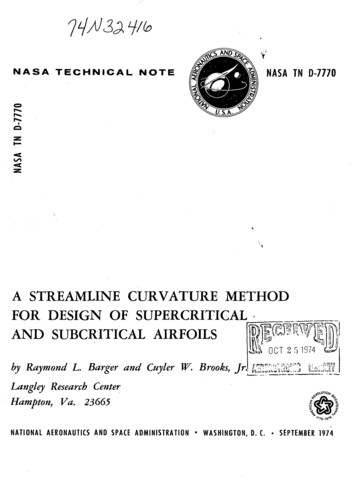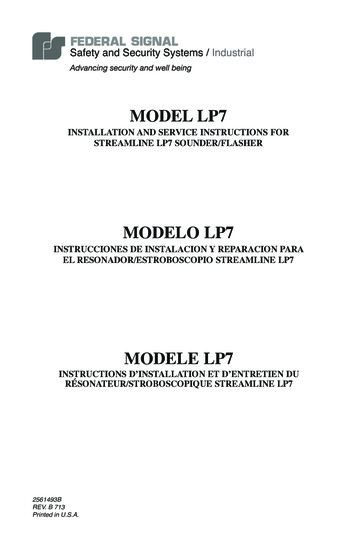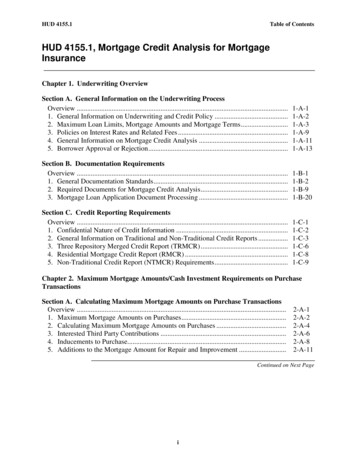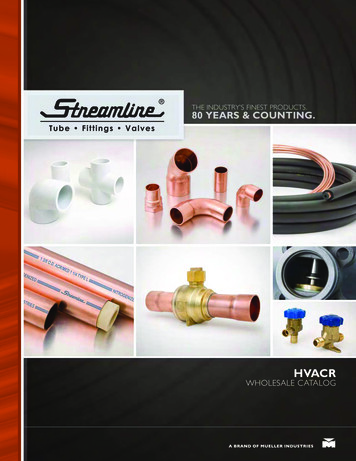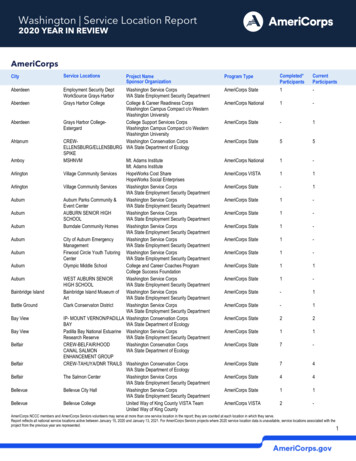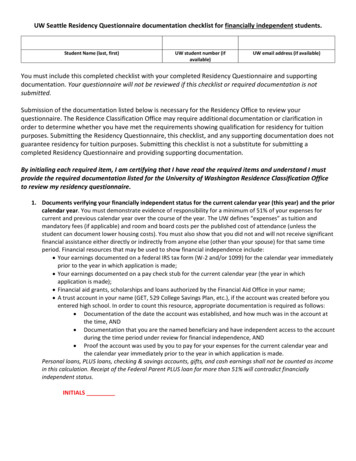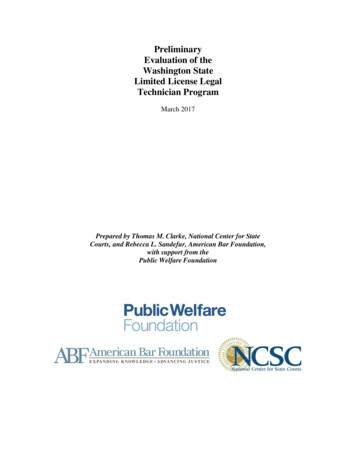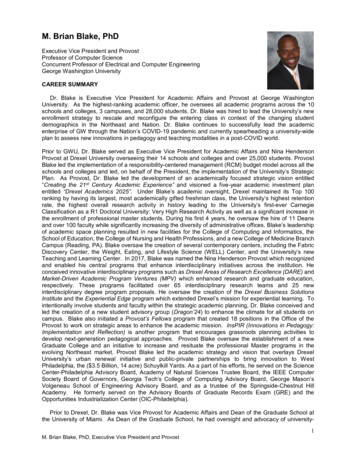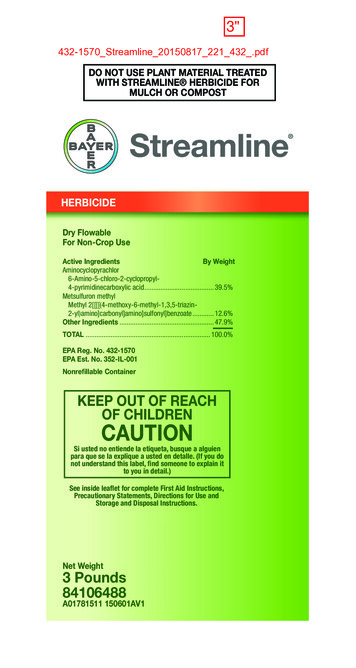
Transcription
68571 book art 7/7/15 10:32 AM Page 13"432-1570 Streamline 20150817 221 432 .pdfDO NOT USE PLANT MATERIAL TREATEDWITH STREAMLINE HERBICIDE FORMULCH OR COMPOSTStreamlineHERBICIDEDry FlowableFor Non-Crop UseActive IngredientsBy ropyl4-pyrimidinecarboxylic acid. 39.5%Metsulfuron methylMethyl arbonyl]amino]sulfonyl]benzoate. 12.6%Other Ingredients . 47.9%TOTAL . 100.0%EPA Reg. No. 432-1570EPA Est. No. 352-IL-001Nonrefillable ContainerKEEP OUT OF REACHOF CHILDRENCAUTIONSi usted no entiende la etiqueta, busque a alguienpara que se la explique a usted en detalle. (If you donot understand this label, find someone to explain itto you in detail.)See inside leaflet for complete First Aid Instructions,Precautionary Statements, Directions for Use andStorage and Disposal Instructions.Net Weight3 Pounds84106488A01781511 150601AV1file: 68571 book artfolder: 68571 Bayer cropscience lp 84106488color: cmykdp proofedcreated: 6-22-15 bmalt: 7-7-15 bmsize: 3”(w) x 6.5”(h)
68571 book art 6/29/15 9:14 AM Page 23"FIRST AIDIF IN EYES: Hold eye open and rinse slowly and gently withwater for 15-20 minutes. Remove contact lenses, if present,after the first 5 minutes, then continue rinsing eye. Call apoison control center or doctor for treatment adviceIF ON SKIN OR CLOTHING: Take off contaminatedclothing. Rinse skin immediately with plenty of water for15-20 minutes. Call a poison control center or doctor forfurther treatment advice.Have the product container or label with you when callinga poison control center or doctor, or going for treatment.You may also contact 1-800-334-7577 for emergencymedical treatment information.PRECAUTIONARY STATEMENTSHAZARDS TO HUMANSAND DOMESTIC ANIMALSCauses moderate eye irritation. Harmful if absorbedthrough skin. Avoid contact with skin, eyes, or clothing.USER SAFETYRECOMMENDATIONSUSERS SHOULD: Wash thoroughly with soap andwater after handling and before eating, drinking, chewinggum, using tobacco, or using the toilet. Removeclothing/PPE immediately if pesticide gets inside. Thenwash thoroughly and put on clean clothing.PERSONAL PROTECTIVE EQUIPMENT (PPE)Applicators and other handlers must wear:Long-sleeved shirt and long pants.Shoes plus socks.Follow manufacturer's instructions for cleaning/ maintainingPPE. If no such instructions for washables exist, usedetergent and hot water. Keep and wash PPE separatelyfrom other laundry.ENVIRONMENTAL HAZARDSDo not apply directly to water, or to areas where surfacewater is present, or to intertidal areas below the meanhigh water mark. Do not contaminate water whendisposing of equipment washwaters or rinsate.This herbicide is injurious to plants at extremely lowconcentrations. Nontarget plants may be adverselyeffected from drift and run-off.(continued)2
68571 book art 7/1/15 7:47 AM Page 33"ENVIRONMENTAL HAZARDS(continued)Surface Water AdvisoryThis product may impact surface water quality due to runoffof rain water. This is especially true for poorly draining soilsand soils with shallow ground water. This product isclassified as having high potential for reaching surfacewater via runoff for several months after application. Alevel, well-maintained vegetative buffer strip between areasto which this product is applied and surface water featuressuch as ponds, streams, and springs will reduce thepotential loading of aminocyclopyrachlor from runoff waterand sediment. Runoff of this product will be reduced byavoiding applications when rainfall is forecasted to occurwithin 48 hours.Ground Water AdvisoryAminocyclopyrachlor has properties and characteristicsassociated with chemicals detected in ground water. Thischemical may leach into ground water if used in areaswhere soils are permeable, particularly where the watertable is shallow.DIRECTIONS FOR USEIt is a violation of Federal law to use this product in amanner inconsistent with its labeling. For any requirementsspecific to your State or Tribe, consult the agencyresponsible for pesticide regulation.Streamline Herbicide must be used only in accordance withdirections on this label or in separately published BAYERCROPSCIENCE LP labeling.BAYER CROPSCIENCE LP will not be responsible forlosses or damages resulting from the use of this product inany manner not specifically instructed by BAYERCROPSCIENCE LP. User assumes all risks associated withsuch non-labeled use.PRODUCT INFORMATIONStreamline Herbicide is a dispersible granule that is mixedin water and applied as a spray. Streamline Herbicide maybe applied by aerial or ground equipment for control ofbroadleaf weeds and woody species, including manyterrestrial and riparian invasive and noxious weeds.Streamline Herbicide is registered for general weed andbrush control on private, public and military lands as follows:uncultivated non-agricultural areas (such as airports,highway, railroad and utility rights-of-way, sewage disposalareas, etc.); uncultivated agricultural areas - non-cropproducing (such as farmyards, fuel storage areas, fencerows, non-irrigation ditchbanks, barrier strips, etc.);industrial sites - outdoor (such as lumberyards, pipeline andtank farms, etc.) and natural areas (such as wildlifemanagement areas, wildlife openings, wildlife habitats).3
68571 book art 6/23/15 1:25 PM Page 43"This product may be applied to terrestrial non-crop sites thatcontain areas of temporary surface water caused by collectionof water, in equipment ruts, or in other depressions created bymanagement activities. It is permissible to treat intermittentlyflooded low lying sites, seasonally dry flood plains andtransitional areas between upland and lowland sites when nowater is present. It is also permissible to treat marshes,swamps and bogs after water has receded, as well asseasonally dry flood deltas. Streamline Herbicide may beapplied up to the waters edge. Do not apply directly to water.Streamline Herbicide provides preemergence and/orpostemergence control of the broadleaf weeds, vines andbrush species listed in the weeds controlled section of thelabel. For perennial species on the label, a postemergenceapplication must be used. For best postemergenceperformance, include an MSO type adjuvant to the spraysolution. Excessive wetting of the target plant is notnecessary but good spray coverage of the target plant isneeded for best results.Streamline Herbicide is non-corrosive to spray equipment.Do not apply more than 11.5 ounces broadcast per acre peryear.BIOLOGICAL ACTIVITYStreamline Herbicide is quickly taken up by the leaves,stems and roots of plants. The effects of Streamline Herbicide may be seen on plants from within a few hours to afew days. The most noticeable symptom is a bending andtwisting of stems and leaves. Other advanced symptomsinclude severe chlorosis, necrosis, stem thickening, growthstunting, leaf crinkling, calloused stems and leaf veins, leafcupping, and enlarged roots. Death of treated broadleaf plantsmay require several more weeks and up to several months forsome woody plant species.Streamline Herbicide is rain-fast at 4 hours afterapplication.IMPORTANT RESTRICTIONS Do not apply this product in areas where the roots ofdesirable trees and/or shrubs may extend unless injury orloss can be tolerated. Root zone areas of desirable treesor vegetation are affected by local conditions and canextend well beyond the tree canopy. Do not apply this product if site-specific characteristicsand conditions exist that could contribute to movementand unintended root zone exposure to desirable trees orvegetation unless injury or loss can be tolerated. Do not make applications when circumstances favormovement from treatment site. Do not apply Streamline Herbicide to roadsides or othernon-crop areas during periods of intense rainfall, orwhere prevailing soils are either saturated with water orof a type through which rainfall will not readily penetrate,as this may result in off-site movement. Do not apply or otherwise permit this product or sprayscontaining this product to come into contact with any nontarget crop or desirable vegetation. Do not apply in or on dry or water containing irrigationditches or canals including their outer banks. Do not apply through any type of irrigation system.4
68571 book art 6/23/15 1:25 PM Page 53" Do not contaminate water intended for irrigation. To avoidinjury to crops or other desirable vegetation, do not treator allow spray drift or run-off to fall onto banks or bottomsof irrigation ditches, either dry or containing water, or otherchannels that carry water that may be used for irrigationpurposes. Treatment of powdery, dry soil and light, sandy soils whenthere is little likelihood of rainfall soon after treatment mayresult in off target movement and possible damage tosusceptible crops and desirable vegetation when soilparticles are moved by wind or water. Injury to crops ordesirable vegetation may result if treated soil is washed,blown or moved onto land used to produce crops or landcontaining desirable vegetation. Do not apply Streamline Herbicide when these conditions are identified andpowdery, dry soil or light or sandy soils are known to beprevalent in the area to be treated. Do not apply when the soil is frozen or covered with snow. Do not use on lawns, walks, driveways, tennis courts, orsimilar areas. Do not use this product in California. Do not use this product in the following counties ofColorado: Saguache, Rio Grande, Alamosa, Costilla andConejos. For sites listed in this label, do not apply more than a totalof 11.5 ounces of product per acre per year as a result ofbroadcast, spot or repeat applications. Do not graze or feed forage, hay or straw from treatedareas to livestock. Do not use plant material treated with this product formulch or compost. If non-crop sites treated with Streamline Herbicide areto be converted to a food, feed, or fiber agricultural crop,or to a horticultural crop, do not plant the treated sites forat least one year after the Streamline Herbicideapplication. A field bioassay must then be completedbefore planting the desired crop. Not for sale, sale into, distribution and/or use in Nassauand Suffolk counties of New York State.SPRAY DRIFT RESTRICTIONSAERIAL APPLICATIONSWhen applying by air, apply only using nozzles which willdeliver coarse or greater (VMD 350 microns) droplets asdefined by ASABE S572 standard. Do not release spray ata height greater than 10 feet above the ground or canopyunless a greater height is required for aircraft safety. Do notapply when wind speed is greater than 10 mph. Do notapply during a temperature inversion.For aerial applications near susceptible crops or otherdesirable plants, use a drift control additive asrecommended by the manufacturer, or apply through a“Microfoil” or “Thru-Valve” boom, or use an equivalent driftcontrol system. Thickened sprays prepared by using highviscosity invert systems or other drift control systems maybe utilized if drift control is comparable to that obtained withdrift control additives or the “Thru-Valve” boom. If a spraythickening agent is used, follow all recommendations andprecautions on the product label. Do not use a thickening5
68571 book art 6/23/15 1:25 PM Page 63"agent with the “Microfoil” boom or other systems that cannotaccommodate thick sprays.GROUND APPLICATIONSWhen applying by ground, apply only using nozzles whichwill deliver coarse or greater (VMD 350 microns) dropletsas defined by ASABE S572 standard. Do not apply with anozzle height greater than 4 feet above the ground orcanopy unless necessitated by the application equipment.Apply with the spray boom or nozzle height as low aspossible. Do not apply when wind speed is greater than 10mph. Do not apply during a temperature inversion.See Spray Drift Management Section of this label foradditional information.IMPORTANT PRECAUTIONS Certain species may, in particular, be sensitive to low levelsof Streamline Herbicide including but not limited to,conifers (such as Douglas fir, Norway spruce, ponderosapine and white pine), deciduous trees (such as aspen,Chinese tallow, cottonwood, honey locust, magnolia,poplar species, redbud, silver maple, and willow species),and ornamental shrubs (such as arborvitae, burning bush,crape myrtle, forsythia, hydrangea, ice plant, magnolia,purple plum and yew). Injury or loss of desirable trees or vegetation may result ifStreamline Herbicide is applied on or near desirabletrees or vegetation, on areas where their roots extend, orin locations where the treated soil may be washed ormoved into contact with their roots. Consider site-specificcharacteristics and conditions that could contribute tounintended root zone exposure to desirable trees orvegetation. Root zone areas of desirable trees orvegetation are affected by local conditions and can extendbeyond the tree canopy. If further information is neededregarding root zone area, consult appropriate stateextension service, professional consultant or otherqualified authority. Injury to or loss of desirable trees or vegetation may resultif equipment is drained or flushed on or near these treesor vegetation, or on areas where their roots may extend,or in locations where the chemical may be washed ormoved into contact with their roots. In non-crop areas adjacent to desirable vegetation, avoidoverlapping spray applications and shut off spray to thespray boom while starting, turning, slowing or stopping toavoid injury to desirable vegetation. Applications made where runoff water flows onto agriculturalland may injure or kill crops, such as but not limited to sugarbeets, potatoes, tomatoes, tobacco, soybeans, field beans,alfalfa, grapes, peaches, almonds, and vegetables. Applications should be made only when there is little or nohazard from spray drift. Very small quantities of spray, whichmay not be visible, may seriously injure susceptible plants. Exposure to Streamline Herbicide may injure or kill mostcrops and may injure or kill desirable vegetation. Injurymay be more severe when the crops or desirablevegetation are irrigated.6
68571 book art 6/23/15 1:25 PM Page 73" Caution is advised when using this product in areas whereloss of desirable conifer or deciduous trees and/or shrubsas well as other broadleaf plants, including but not limitedto, legumes and wild flowers, cannot be tolerated. Withoutprior experience, it is necessary that small areascontaining these plants be tested for tolerance toStreamline Herbicide and its soil residues before anylarge scale spraying occurs. Low rates of Streamline Herbicide can kill or severelyinjure most crops. Following a Streamline Herbicideapplication, the use of spray equipment to apply otherpesticides to crops on which Streamline Herbicide is notregistered may result in their damage. The most effectiveway to reduce this crop damage potential is to usededicated mixing and application equipment. Leave treated soil undisturbed to reduce the potential forStreamline Herbicide movement by soil erosion due towind or water. In the case of suspected off-site movement of Streamline Herbicide to cropland, soil samples should be quantitativelyanalyzed for Streamline Herbicide or any other herbicidewhich could be having an adverse effect on the crop, inaddition to conducting the field bioassay. Streamline Herbicide may suppress or severely injurecertain established grasses, such as some bromegrass andwheatgrass species, especially when the grass plants arestressed by adverse environmental conditions. Areas thatcontain these grass plants should recover as environmentalconditions for good grass growth occur.FIELD BIOASSAYTo conduct a field bioassay, grow to maturity test strips ofthe crop you plan to grow the following year. The test stripsmust cross the entire field including knolls and low areas.Crop response to the field bioassay will indicate whether ornot to plant the crops grown in the test strips. If no cropinjury (such as poor germination, stunting, or chlorosis,malformation, or necrosis of leaves) or yield loss is evidentfrom the crops grown in the test strips, the intendedrotational crop may be planted. If herbicide symptoms oryield loss is observed do not plant the crop.TANK MIXTURESStreamline Herbicide may be tank mixed with otherherbicides which are registered for the same use sites,methods of application and timings as specified on thisproduct label. Refer to the tank mix product label for anyadditional instructions or use restrictions. Include a sprayadjuvant with Streamline Herbicide when makingpostemergence applications. Refer to the adjuvant label foradditional instructions or use restrictions. When tank mixing,use the most restrictive label limitations for each of theproducts being used in the tank mix.ADJUVANTSMethylated Seed Oils and Vegetable Oils: A methylatedseed oil (MSO) or vegetable oil based adjuvant may provideincreased leaf absorption of Streamline Herbicide. Includethe MSO or vegetable oil adjuvant at 0.5% to 1% v/v (2quarts to 1 gallon per 100 gallons of spray solution).7
68571 book art 6/23/15 1:25 PM Page 83"Non-ionic Surfactants: Use a non-ionic surfactant at a rateof 0.25% to 1% v/v ( 0.5 to 1 gallon of surfactant per 100gallons of spray solution). Surfactant products must containat least 70% constituents effective as spray additives.Crop Oil Concentrate (COC): Apply petroleum-based cropoil concentrate at 1% v/v (1 gallon per 100 gallons spraysolution) or 2% under arid conditions. Oil adjuvants must contain at least 80% high quality,petroleum (mineral) or modified vegetable seed oil with atleast 15% surfactant emulsifiers.INVERT EMULSIONSStreamline Herbicide may be applied as an invertemulsion. The spray solution results in an invert (water-inoil) spray emulsion designed to minimize spray drift andspray run-off, resulting in more herbicide deposited on thetarget foliage. The spray emulsion may be formed in a singletank (batch mixing) or injected (in-line mixing). Consult theinvert chemical label for proper mixing directions.INVASIVE SPECIES MANAGEMENTThis product may be considered for use on public, private,and tribal lands to treat certain weed species infestationsthat have been determined to be invasive, consistent withthe Federal Interagency Committee for the Management ofNoxious and Exotic Weeds (FICMNEW) National EarlyDetection and Rapid Response (EDRR) System for invasiveplants. Effective EDRR systems address invasions byeradicating the invader where possible, and controlling themwhen the invasive species is too established to be feasiblyeradicated. Once an EDRR assessment has beencompleted and action is recommended, a Rapid Responseneeds to be taken to quickly contain, deny reproduction, andif possible eliminate the invader. Consult your appropriatestate extension service, forest service, or regionalmultidisciplinary invasive species management coordinationteam to determine the appropriate Rapid Responseprovisions and allowed treatments in your area.RESISTANCEWhen herbicides that affect the same biological site of actionare used repeatedly over several years to control the sameweed species in the same site, naturally-occurring resistantbiotypes may survive a correctly applied herbicide treatment,propagate, and become dominant in that field.Adequate control of these resistant weed biotypes cannotbe expected. If weed control is unsatisfactory, it may benecessary to retreat the problem area using a productaffecting a different site of action. To better manageherbicide resistance through delaying the proliferation andpossible dominance of herbicide resistant weed biotypes, itmay be necessary to change practices such as using acombination of retreatment, tank-mix partners and/orsequential herbicide applications that have a different siteof action. Weed escapes that are allowed to go to seed willpromote the spread of resistant biotypes. It is advisable tokeep accurate records of pesticides applied to individual8
68571 book art 6/23/15 1:25 PM Page 93"sites to help obtain information on the spread and dispersalof resistant biotypes. Consult your agricultural reseller,consultant, applicator, and/or appropriate state agriculturalextension service representative for specific alternativecultural practices or herbicide recommendations availablein your area.INTEGRATED PEST MANAGEMENTThis product may be used as part of an Integrated PestManagement (IPM) program that can include biological,cultural, and genetic practices aimed at preventingeconomic pest damage. IPM principles and practicesinclude site scouting or other detection methods, correcttarget pest identification, population monitoring, andtreating when target pest populations reach locallydetermined action thresholds. Consult your statecooperative extension service, professional consultants, orother qualified authorities to determine appropriate actiontreatment threshold levels for treating specific pest systemsin your area.PREPARING FOR USE SITE SPECIFIC CONSIDERATIONSUnderstanding the risks associated with the application ofStreamline Herbicide is essential to aid in preventing offsite injury to desirable vegetation and agricultural crops. Therisk of off-site movement both during and after applicationmay be affected by a number of site specific factors suchas the nature, texture and stability of the soil, the intensityand direction of prevailing winds, vegetative cover, siteslope, rainfall, drainage patterns, and other local physicaland environmental conditions. A careful evaluation of thepotential for off-site movement from the intended applicationsite, including movement of treated soil by wind or watererosion, must be made prior to using Streamline Herbicide. This evaluation is particularly critical wheredesirable vegetation or crops are grown on neighboring landfor which the use of Streamline Herbicide is not labeled. Ifprevailing local conditions may be expected to result in offsite movement and cause damage to neighboring desirablevegetation or agricultural crops, do not apply Streamline Herbicide.Before applying Streamline Herbicide the user must readand understand all label directions, precautions andrestrictions completely, including these requirements for asite specific evaluation. If you do not understand any of theinstructions or precautions on the label, or are unable tomake a site specific evaluation yourself, consult with yourlocal BAYER CROPSCIENCE LP Crop Protectionrepresentative, local agricultural dealer, universitycooperative extension service, land manager, professionalapplicator, agricultural consultant, or other qualifiedauthorities familiar with the area to be treated. If you still havequestions regarding the need for site specific considerationsplease call 1-800-331-2867.9
68571 book art 6/23/15 1:25 PM Page 103"NON-AGRICULTURAL USESNON-AGRICULTURAL USEREQUIREMENTSThe requirements in this box apply to uses of this productthat are not within the scope of the Worker ProtectionStandard (WPS) for agricultural pesticides (40 CFR Part170). The WPS applies when this product is used to produceagricultural plants on farms, forests, nurseries, orgreenhouses. Terrestrial non-crop weed control is not withinthe scope of the Worker Protection Standard. See theProduct Information section of this label for a description ofnoncrop sites.Do not enter or allow others to enter the treated area untilsprays have dried.APPLICATION INFORMATIONNON-CROP SITESStreamline Herbicide is a dispersible granule that is mixedin water and applied as a spray. Streamline Herbicide maybe applied broadcast using ground spray equipment, fixedwing aircraft or by helicopter. When applying by fixed wingaircraft or helicopter, follow directions under the AerialApplications section of this label, otherwise refer to the sectionon Ground Applications when using surface equipment.Apply Streamline Herbicide preemergence or earlypostemergence when broadleaf weeds are activelygerminating or growing. For perennial species on the label, apostemergence application must be used. Streamline Herbicide can provide long term control of susceptible weeds.The length of control is dependent upon the application rate,condition and growth stage of target weeds, environmentalconditions at and following application, and the density andvigor of competing desirable vegetation. Best results for longterm weed and brush control occur when grasses and otherdesired vegetation are allowed to recover from adverseenvironmental conditions and compete with undesirable brushor weeds.Weeds hardened off by cold weather or drought stress maynot be controlled.Streamline Herbicide may also be applied using low andhigh volume ground spray equipment.Regardless of the application volume or spray equipmentused, thorough coverage of the brush and weed foliage isnecessary to optimize control results.INDUSTRIAL TURFGRASS(UNIMPROVED ONLY)Application InformationStreamline Herbicide is labeled for selective broadleafweed control in unimproved, well established industrial androadside turfgrasses. Streamline Herbicide is also labeledfor the control of certain noxious and troublesome weedsin industrial turfgrass. Use a surfactant at the rate of 1 to 210
68571 book art 6/23/15 1:25 PM Page 113"pints per 100 gallons of spray solution. A transient yellowingand/or stunting may be observed following an application ofStreamline Herbicide.In addition to conventional spray equipment, Streamline Herbicide may also be applied with invert emulsionequipment. When using an invert emulsion, mix the prescribedrate of Streamline Herbicide in the water phase.For turfgrass species that are not listed on this label,determine the suitability for such uses by treating a smallarea at a labeled application rate. Prior to treatment of largerareas, the treated area must be observed for any signs ofherbicidal injury during 30 days of normal growing conditionsto determine if the treatment is safe to the target species.The user assumes the responsibility for any plant damageor other liability resulting from use of Streamline Herbicideon a turfgrass species not listed on this label.Excessive injury may result when Streamline Herbicide isapplied to turfgrass that is under stress from drought, insects,disease, cold temperatures (winter injury) or poor fertility.TURFGRASS TYPEBermudagrassBluegrass, KentuckyTall FescueRyegrass, perennial1Wheatgrass species2Smooth brome2RATEOUNCES/ACRE1.75 to 5.01.75 to 5.01.75 to 5.01.75 to 3.01.75 to 4.751.75 to 4.75 Transient injury (stunting, yellowing, seedhead suppression)can occur to industrial and roadside turfgrasses fromapplications of Streamline Herbicide. Applications to bermudagrass, Kentucky bluegrass and tallfescue industrial and roadside turfgrasses can causetransient stunting, yellowing and/or seedhead suppression.To reduce these transient symptoms, make applicationlater in the spring after new growth is 4 to 6 inches tall ormake application in the fall.1. Do not apply Streamline Herbicide to this turfgrassspecies unless potential turfgrass injury can be tolerated.Do not apply more than 3.0 ounces of Streamline Herbicide per acre. Use surfactant at the rate of 0.5 to 1pint per 100 gallons of spray solution.2. For crested and western wheatgrasses and smoothbrome the injury (stunting, seedhead suppression) at thehigher rates during the season of application may besevere. Areas that contain these turfgrass plants shouldrecover as environmental conditions for good turfgrassgrowth occur.SPECIFIC WEED PROBLEMS: COGONGRASSIn roadside turfgrass sites, apply Streamline Herbicide ata minimum of 5 ounces per acre for seedhead suppressionof cogongrass. For cogongrass control (stand reduction),apply Streamline Herbicide at 10 to 11 ounces per acre.Multiple applications will be required for best control, notexceeding 11.5 ounces per acre per year. Best results whenapplied after final seasonal mowing of roadsides. Makeapplications in the fall prior to frost (applications generallybegin in September).11
68571 book art 6/23/15 1:25 PM Page 123"BRUSH AND BROADLEAF WEEDCONTROLLOW VOLUME FOLIAR APPLICATIONSee Table 1. STREAMLINE HERBICIDE Spray Volumeand Use Rate Mixing Instructions chart. Adjust theStreamline Herbicide spray concentration according to thespray volume per acre and the size and plant density of thetarget brush species. For best results, include an MSOadjuvant at the rate of 1% v/v. Good plant coverage isnecessary for best results. Use spray nozzles and pressurethat will aid the proper deposition of the spray solution.Apply in sufficient spray volume to insure uniform spraydistribution of spray particles over the area to be treated andto avoid spray drift. Use the higher concentration rates fordense brush canopies and hard to control brush species.The application volume required will vary with the height anddensity of the brush and the type of application equipment.In general, low volume ground application spray volumesrange from 20 to 50 gallons per acre.Ultra-low volume ground application spray volumes mayrange from 10 to 20 gallons per acre.For low volume foliar applications, mix 30 to 46 ounces ofStreamline Herbicide per 100 gallons of spray solution. Donot apply more than 25 gallons of the spray solution peracre at the 46 ounces per 100 gallon spray solution.See Table 1. STREAMLINE HERBICIDE Spray Volumeand Use Rate Mixing Instructions chart.HIGH VOLUME FOLIAR APPLICATIONHigh volume applications may be applied at rates equivalentto broadcast rates up to 11.5 ounces product per acre peryear. Where a rate range is indicated for the brush species,use the higher rate for high density brush sites. For bestresults, use MSO adjuvant at the rate of 1% V/V to the spraysolution.When making bro
Sep 14, 2015 · Streamline DO NOT USE PLANT MATERIAL TREATED WITH STREAMLINE HERBICIDE FOR MULCH OR COMPOST 68571_book art 7/7/15 10:32 AM Page 1. 3" 432-1570_Streamline_20150817_221_432_.pdf. FIRST AID. IF IN EYES: Hold eye open and rinse slowly and gently with wa
